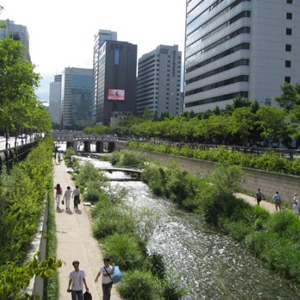
In 2008, Seoul’s mayor, Oh Se-Hoon, announced that he was determined to make Seoul one of the world’s greenest metropolitan centres and an example to the C40 – formely the Large Cities Climate Leadership Group – of which Seoul is a member. In an article for the UN’s Urban World magazine in 2009, Oh said that he planned to get Seoul to reduce energy use by 20 per cent, reduce carbon emissions by 40 per cent and increase the use of renewable energy by 20 per cent, all by 2030.
Since taking office in July 2006, Oh and the Seoul Metropolitan Government (SMG) have worked hard to tackle one of Seoul’s biggest problems: air pollution. Over the past few decades, satellite towns have sprung up around the capital, increasing the use of private cars.
Population growth may have slowed down since the 1980s, but the population of Seoul over the past decade has nevertheless risen from 9.8 million in 2000 to nearly 10.5 million people in 2010. Car-ownership has also increased: in 2003, 215 in every 1,000 South Koreans owned a car; by 2005 that figure had risen to 319. This gives some indication of how numbers will have grown in the past five years, with those of Seoul often higher than the national average.
Despite efforts by the SMG to encourage the use of greener cars, the sheer number of vehicles on the street has cancelled out any effort to reduce air pollution. Until recently the regulations to tackle exhaust fumes were almost non-existent, making cars one of the greatest causes of air pollution in the city. The increase in particulates over the decades led to a rise in respiratory infections, with the life-expectancy in Seoul approximately five years lower than elsewhere in South Korea.
In order to tackle this problem, Oh reduced fares on Seoul’s Metro and bus systems to the equivalent of less than £1, and made plans to connect the ever-growing satellite towns to central Seoul by building seven new train lines to be incorporated into the Metro and overground systems. In 2008 Seoul had already converted its 72,000-strong taxi fleet to run on liquefied petroleum gas instead of petrol, while this year saw Seoul’s fleet of buses complete the move from diesel to compressed natural gas. This push to become an example to the C40 cities led to a 10 per cent decrease in air particles in 2008 alone, a drop of more than 90 per cent since records started in 1980.
via Seoul: on course to be one of the world’s greenest cities?